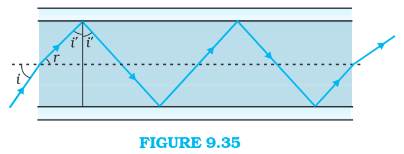(a) Figure 9.35 shows a cross-section of a ‘light pipe’ made of a glass fibre of refractive index 1.68. The outer covering of the pipe is made of a material of refractive index 1.44. What is the range of the angles of the incident rays with the axis of the pipe for which total reflections inside the pipe take place, as shown in the figure.
(b) What is the answer if there is no outer covering of the pipe?

Given:
(a) Refractive index of the glass fibre,
Refractive index of the outer covering of the pipe, μ2 = 1.44
Angle of incidence = i°
Angle of refraction = r°
Angle of incidence at the interface = i’
The refractive index (μ) of the core interface is given as:
μ = ![]() …(1)
…(1)
Where,
�2 = refractive index of outer covering
�1 = refractive index of inner covering
i’ = angle of incidence at interface
From equation (1)
sin i’ = �1/ �2
⇒ sin i’ = 1.44/1.68
⇒ i' = 59°
For the critical angle, total internal reflection takes place only when i > i’,
i.e., i > 59°
Maximum angle of reflection,
rmax = 90°−i′
⇒ rmax = 90°−59° = 31°
Let, imax be the maximum angle of incidence.
The refractive index at the air − glass interface, μ1 = 1.68
⇒ ![]()
⇒ sin imax = �1 × sin rmax
sin imax = 1.68 × 0.5150 = 0.8652
Therefore imax = sin-1(0.86)
imax = 60°
Thus, all the rays incident at angles lying in the range 0 < i < 60° will suffer total internal reflection.
(b) If the outer covering of the pipe is not present, then:
Refractive index of the outer pipe, μ1 = Refractive index of air = 1
For the angle of incidence i = 90°, we can write Snell’s law at the air − pipe interface as:
sin i /sin r = μ
Where,
i = angle of incidence
r = angle of refraction
sin i/ sin r = 1.68
sinr = sin90°/1.68
Sin r = 1/1.68
r = 36.5°
i’ = 90° - r
⇒ i′ = 90°−36.5°
⇒ i’ = 53.5°
Since i’ > r, all incident rays will suffer total internal reflection.